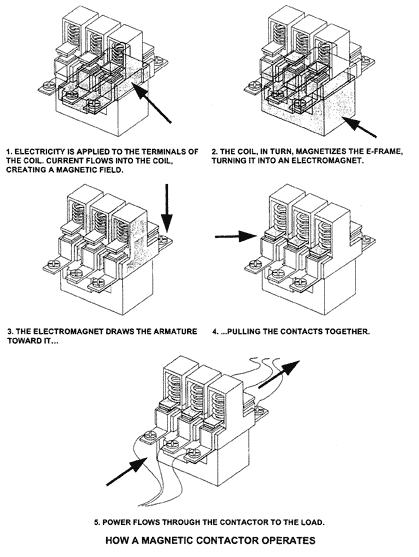Contactor
What is a Contactor?
Contactor can stand on its own as a power control device. They are used in applications from a light switch to complex, automated equipment. Contactors are in equipment that is frequently turned off and on (circuits opening and closing) such as lighting circuits, transformers, heaters and motors.
The function of the contactor is always the same, whatever the application: to make and break all power supply lines
running to a load. NEMA defines it as repeatedly establishing and interrupting an electrical power circuit.

How Contactors Operate
Magnetic contactors use a small control current to open and close the circuit. The E-Frame, when energized by the coil,
becomes an electromagnet. The armature, a companion to the E-Frame, is connected to a set of contacts. The armature is
moveable and held by a spring. When the coil is energized, the moveable contacts are pulled toward the stationary contacts because the armature is pulled toward the E-Frame. Once the two sets of contacts meet, power can flow through the contactor to the load. When the coil is de-energized, the magnetic field is broken and the spring forces the two sets of contacts apart.
Arcing

Bouncing
Modern contactors are designed to close so quickly and with such energy that contacts slam against each other and rebound, causing a bouncing action. It is referred to as contact bounce. When the contact bounces away, a secondary arc is created. The contacts slam together again and again, each time reducing the bouncing and arcing. For longer contact life, the contacts should close as fast as possible with minimal bounce to reduce secondary arc and wear.
When to Replace Contacts
Visual inspection and wear measurement is useful in determining when contacts need replacement. Replace contacts if there is extreme pitting and curling of the corners, or if the contact has eroded at the corners to a point that the contact bridge is beginning to show. Even if contacts appear good, abnormal wear indicates replacement is necessary.
Do not file silver contacts. Filing removes surface area and shortens the contacts life. It does not improve performance nor does it extend the life of the contact.
Visual Inspection
Caution: Never inspect contacts without disconnecting the power at the branch circuit disconnecting device. In starters provided with a separate low voltage power supply, disconnect the separate control source.
A new contact usually has a uniform silver color. As electrical wear occurs, the silver color may change to blue, brown or black. The black color is a result of silver oxidation that is beneficial to contact operation. The presence of small black embedded granules indicates cadmium oxide that is also an excellent electrical conductor.
Contour irregularities involve a slantwise wear. For example, one corner may wear faster than the other three. This is normal. If one contact is almost in direct contact with the plate, the contact needs replacement. If left unchecked, and the plate material is contacted, the contacts could weld to the housing. If this occurs, the entire device would need replacement rather than just the contacts.
Material melting and vaporization causes pitting. The pitted surface has high and low spots. Pitting of a well-wearing contact has a uniform surface and can actually provide a better contact than a smooth surface. The size of the pit mark or crater is proportional to the amperes of the arcing current. High amperage contacts have larger pit marks than low amperage versions. Replace the contact when chunks are torn away from the arcing surface.
Curling is a condition where the corners of the fastened contact separate from its plate. Curling is a result of very high heat production. High heat is produced when severe inching or jogging of the contactor occurs, or when the device is subjected to short circuit faults or ground faults in the system. If curling continues to exist after the contacts are replaced, verify if the contactor is properly rated for the application or if other associated equipment is operating properly.
To inspect the contacts, remove the contact block cover and slide out the moveable contact bar. Chances are if the moveable contacts are in reasonable shape, the stationary contacts are also in good condition.

